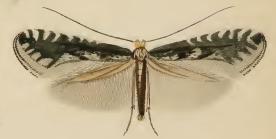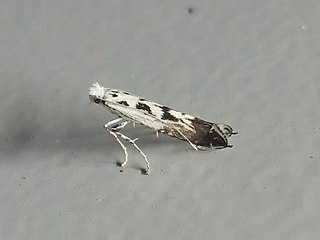
Gracillariidae is an important family of insects in the order Lepidoptera and the principal family of leaf miners that includes several economic, horticultural or recently invasive pest species such as the horse-chestnut leaf miner, Cameraria ohridella.

Phyllonorycter agilella is a moth of the family Gracillariidae. It is found in Latvia central Russia, Pyrenees, Italy and Bulgaria and from France to eastern Russia.

Parornix petiolella is a moth of the family Gracillariidae. It is known from Austria, Bulgaria, the Czech Republic, France, Germany, Hungary, Italy, Kazakhstan, Luxembourg, Moldova, Poland, Romania, the European part of Russia, Slovakia, Switzerland and Ukraine.
Parornix szocsi is a moth of the family Gracillariidae. It is known from Austria, the Czech Republic, Hungary, Sardinia, Kazakhstan, Romania, the European part of Russia, Slovakia, Spain, Tajikistan and Ukraine.
Caloptilia rhodinella is a moth of the family Gracillariidae. It is known from Albania, Austria, Croatia, Germany, Hungary, Italy, Romania, Serbia, Switzerland, Turkey, the European part of Russia, India and China (Sichuan).
Gracillaria loriolella is a moth of the family Gracillariidae. It is known from Norway, France, Switzerland, Austria, the Czech Republic, Poland, Hungary, Moldova, the European part of Russia, Ukraine, Tajikistan, Turkmenistan.

Ornixola caudulatella is a moth of the family Gracillariidae. It is known from France, Italy, Germany, Austria, Poland, Hungary, Slovakia, the Czech Republic, Romania, Greece, Lithuania, Latvia, Estonia, Russia and Ukraine.
Aristaea bathracma is a species of moth of the family Gracillariidae. It is known from China, Thailand, Japan (Honshū), the Russian Far East, Mozambique, South Africa, Réunion and Uganda.
Spulerina astaurota is a moth of the family Gracillariidae. It is known from India, Japan, Korea and the Russian Far East.
Spulerina dissotoma is a moth of the family Gracillariidae. It is known from India (Bihar), Japan, Korea, the Russian Far East and Taiwan.
Phyllonorycter jozanae is a moth of the family Gracillariidae. It is known from Hokkaidō island in Japan and from the Russian Far East.
Parornix multimaculata is a moth of the family Gracillariidae. It is known from the Japan (Hokkaidō), Korea and the Russian Far East.
Phyllonorycter nigristella is a moth of the family Gracillariidae. It is found on the islands of Hokkaidō, Honshū and Shikoku in Japan and in the Russian Far East.
Eteoryctis deversa is a moth of the family Gracillariidae and genus Eteoryctis. It is known to live in India, Japan, Korea, the Russian Far East, and Taiwan.
Acrocercops transecta is a moth of the family Gracillariidae. It is known from Japan, Korea, the Russian Far East and Taiwan.
Caloptilia mandschurica is a moth of the family Gracillariidae. It is known from China, Japan, Korea and the Russian Far East.
Caloptilia ulmi is a moth of the family Gracillariidae. It is known from China, Japan and the Russian Far East.
Caloptilia sapporella is a moth of the family Gracillariidae. It is known from China, Japan, Korea and the Russian Far East.
Caloptilia issikii is a moth of the family Gracillariidae. It is known from China, Japan and the Russian Far East.

Gracillariinae are a subfamily of moths which was described by Henry Tibbats Stainton in 1854.



